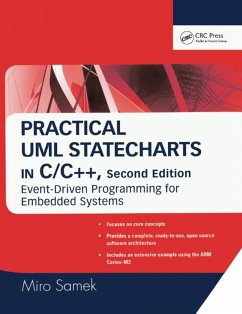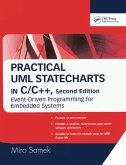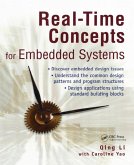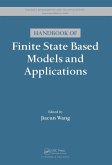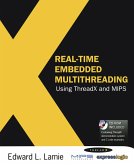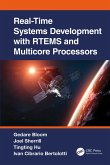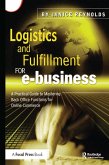Miro Samek
Practical UML Statecharts in C/C++ (eBook, PDF)
Event-Driven Programming for Embedded Systems
56,95 €
56,95 €
inkl. MwSt.
Sofort per Download lieferbar

28 °P sammeln
56,95 €
Als Download kaufen

56,95 €
inkl. MwSt.
Sofort per Download lieferbar

28 °P sammeln
Jetzt verschenken
Alle Infos zum eBook verschenken
56,95 €
inkl. MwSt.
Sofort per Download lieferbar
Alle Infos zum eBook verschenken

28 °P sammeln
Miro Samek
Practical UML Statecharts in C/C++ (eBook, PDF)
Event-Driven Programming for Embedded Systems
- Format: PDF
- Merkliste
- Auf die Merkliste
- Bewerten Bewerten
- Teilen
- Produkt teilen
- Produkterinnerung
- Produkterinnerung

Bitte loggen Sie sich zunächst in Ihr Kundenkonto ein oder registrieren Sie sich bei
bücher.de, um das eBook-Abo tolino select nutzen zu können.
Hier können Sie sich einloggen
Hier können Sie sich einloggen
Sie sind bereits eingeloggt. Klicken Sie auf 2. tolino select Abo, um fortzufahren.

Bitte loggen Sie sich zunächst in Ihr Kundenkonto ein oder registrieren Sie sich bei bücher.de, um das eBook-Abo tolino select nutzen zu können.
Practical UML Statecharts in C/C++ Second Edition bridges the gap between high-level abstract concepts of the Unified Modeling Language (UML) and the actual programming aspects of modern hierarchical state machines (UML statecharts). The book describes a lightweight, open source, event-driven infrastructure, called QP that enables direct manual cod
- Geräte: PC
- mit Kopierschutz
- eBook Hilfe
- Größe: 23.67MB
Andere Kunden interessierten sich auch für
![Practical UML Statecharts in C/C++ (eBook, ePUB) Practical UML Statecharts in C/C++ (eBook, ePUB)]() Miro SamekPractical UML Statecharts in C/C++ (eBook, ePUB)56,95 €
Miro SamekPractical UML Statecharts in C/C++ (eBook, ePUB)56,95 €![Real-Time Concepts for Embedded Systems (eBook, PDF) Real-Time Concepts for Embedded Systems (eBook, PDF)]() Qing LiReal-Time Concepts for Embedded Systems (eBook, PDF)58,95 €
Qing LiReal-Time Concepts for Embedded Systems (eBook, PDF)58,95 €![Handbook of Finite State Based Models and Applications (eBook, PDF) Handbook of Finite State Based Models and Applications (eBook, PDF)]() Handbook of Finite State Based Models and Applications (eBook, PDF)61,95 €
Handbook of Finite State Based Models and Applications (eBook, PDF)61,95 €![Real-Time Embedded Multithreading Using ThreadX and MIPS (eBook, PDF) Real-Time Embedded Multithreading Using ThreadX and MIPS (eBook, PDF)]() Edward LamieReal-Time Embedded Multithreading Using ThreadX and MIPS (eBook, PDF)67,95 €
Edward LamieReal-Time Embedded Multithreading Using ThreadX and MIPS (eBook, PDF)67,95 €![Real-Time Systems Development with RTEMS and Multicore Processors (eBook, PDF) Real-Time Systems Development with RTEMS and Multicore Processors (eBook, PDF)]() Gedare BloomReal-Time Systems Development with RTEMS and Multicore Processors (eBook, PDF)61,95 €
Gedare BloomReal-Time Systems Development with RTEMS and Multicore Processors (eBook, PDF)61,95 €![Teaching Tech Together (eBook, PDF) Teaching Tech Together (eBook, PDF)]() Greg WilsonTeaching Tech Together (eBook, PDF)25,95 €
Greg WilsonTeaching Tech Together (eBook, PDF)25,95 €![Logistics and Fulfillment for e-business (eBook, PDF) Logistics and Fulfillment for e-business (eBook, PDF)]() Janice ReynoldsLogistics and Fulfillment for e-business (eBook, PDF)56,95 €
Janice ReynoldsLogistics and Fulfillment for e-business (eBook, PDF)56,95 €-
-
-
Practical UML Statecharts in C/C++ Second Edition bridges the gap between high-level abstract concepts of the Unified Modeling Language (UML) and the actual programming aspects of modern hierarchical state machines (UML statecharts). The book describes a lightweight, open source, event-driven infrastructure, called QP that enables direct manual cod
Dieser Download kann aus rechtlichen Gründen nur mit Rechnungsadresse in A, B, BG, CY, CZ, D, DK, EW, E, FIN, F, GR, HR, H, IRL, I, LT, L, LR, M, NL, PL, P, R, S, SLO, SK ausgeliefert werden.
Produktdetails
- Produktdetails
- Verlag: Taylor & Francis eBooks
- Seitenzahl: 728
- Erscheinungstermin: 3. Oktober 2008
- Englisch
- ISBN-13: 9781482249262
- Artikelnr.: 54271865
- Verlag: Taylor & Francis eBooks
- Seitenzahl: 728
- Erscheinungstermin: 3. Oktober 2008
- Englisch
- ISBN-13: 9781482249262
- Artikelnr.: 54271865
- Herstellerkennzeichnung Die Herstellerinformationen sind derzeit nicht verfügbar.
Dr. Miro Samek is the founder and president of Quantum Leaps, an open source company providing lightweight, state machine-based, event-driven application frameworks for embedded systems. He is the author of Practical Statecharts in C/C++ (CMP Books, 2002), has written numerous articles for magazines, including a column for C/C++ Users Journal, is a regular speaker at the Embedded Systems Conferences, and serves on the editorial review board of the Embedded Systems Design magazine. For a number of years, he worked in various Silicon Valley companies as an embedded software architect and before that he worked as an embedded software engineer at GE Medical Systems (now GE Healthcare). Dr. Samek earned his Ph.D. in nuclear physics at GSI (Darmstadt, Germany).
Preface PART I STATECHARTS Chapter 1 Whirlwind Tour of Programming with
Statecharts1.1 Why Bother?1.2 The Traditional Event-Action Paradigm1.3
State Machines ? A Better Way of Programming1.3.1 The Time Bomb
Example1.3.2 The Calculator Example1.5 Object-Oriented Analogy1.6 The
Event-driven Framework1.6 SummaryChapter 2 A Crash Course in Statecharts
2.1 The Essence of Finite State Machines2.2 The Essence of UML
Statecharts2.3 Examples of State Models2.4 SummaryChapter 3 Standard State
Machine Implementations3.1 State Machine Interface3.2 Nested switch
Statement3.3 State Table3.4 State Design Pattern3.5 Optimal FSM
Implementation3.6 State Machines and C++ Exception Handling 3.7 Role of
Pointer-to-Member Functions3.8 Implementing Guards, Junctions, and Choice
Points3.9 Implementing Entry and Exit Actions3.10 Dealing with State
Hierarchy3.11 SummaryChapter 4 QEP: A Minimal Hierarchical Event
Processor4.1 General Structure of the QEP Event Processor4.2 An Annotated
Example (QHsm)4.3 QEP Structure4.3.1 QEP Source Code Structure4.3.2
Internal Representation of a State Machine4.3.3 Initialization of a State
Machine4.3.4 Dispatching Events to a FSM4.3.5 Executing a Transition in a
FSM4.3.6 Dispatching Events to a HSM4.3.7 Executing a Transition in a
HSM4.3.8 Static Transition Optimization in a HSM4.4 Porting and Configuring
QEP4.5 Caveats4.6 Su
Statecharts1.1 Why Bother?1.2 The Traditional Event-Action Paradigm1.3
State Machines ? A Better Way of Programming1.3.1 The Time Bomb
Example1.3.2 The Calculator Example1.5 Object-Oriented Analogy1.6 The
Event-driven Framework1.6 SummaryChapter 2 A Crash Course in Statecharts
2.1 The Essence of Finite State Machines2.2 The Essence of UML
Statecharts2.3 Examples of State Models2.4 SummaryChapter 3 Standard State
Machine Implementations3.1 State Machine Interface3.2 Nested switch
Statement3.3 State Table3.4 State Design Pattern3.5 Optimal FSM
Implementation3.6 State Machines and C++ Exception Handling 3.7 Role of
Pointer-to-Member Functions3.8 Implementing Guards, Junctions, and Choice
Points3.9 Implementing Entry and Exit Actions3.10 Dealing with State
Hierarchy3.11 SummaryChapter 4 QEP: A Minimal Hierarchical Event
Processor4.1 General Structure of the QEP Event Processor4.2 An Annotated
Example (QHsm)4.3 QEP Structure4.3.1 QEP Source Code Structure4.3.2
Internal Representation of a State Machine4.3.3 Initialization of a State
Machine4.3.4 Dispatching Events to a FSM4.3.5 Executing a Transition in a
FSM4.3.6 Dispatching Events to a HSM4.3.7 Executing a Transition in a
HSM4.3.8 Static Transition Optimization in a HSM4.4 Porting and Configuring
QEP4.5 Caveats4.6 Su
Preface PART I STATECHARTS Chapter 1 Whirlwind Tour of Programming with Statecharts1.1 Why Bother?1.2 The Traditional Event-Action Paradigm1.3 State Machines ? A Better Way of Programming1.3.1 The Time Bomb Example1.3.2 The Calculator Example1.5 Object-Oriented Analogy1.6 The Event-driven Framework1.6 SummaryChapter 2 A Crash Course in Statecharts 2.1 The Essence of Finite State Machines2.2 The Essence of UML Statecharts2.3 Examples of State Models2.4 SummaryChapter 3 Standard State Machine Implementations3.1 State Machine Interface3.2 Nested switch Statement3.3 State Table3.4 State Design Pattern3.5 Optimal FSM Implementation3.6 State Machines and C++ Exception Handling 3.7 Role of Pointer-to-Member Functions3.8 Implementing Guards, Junctions, and Choice Points3.9 Implementing Entry and Exit Actions3.10 Dealing with State Hierarchy3.11 SummaryChapter 4 QEP: A Minimal Hierarchical Event Processor4.1 General Structure of the QEP Event Processor4.2 An Annotated Example (QHsm)4.3 QEP Structure4.3.1 QEP Source Code Structure4.3.2 Internal Representation of a State Machine4.3.3 Initialization of a State Machine4.3.4 Dispatching Events to a FSM4.3.5 Executing a Transition in a FSM4.3.6 Dispatching Events to a HSM4.3.7 Executing a Transition in a HSM4.3.8 Static Transition Optimization in a HSM4.4 Porting and Configuring QEP4.5 Caveats4.6 Su
Preface PART I STATECHARTS Chapter 1 Whirlwind Tour of Programming with
Statecharts1.1 Why Bother?1.2 The Traditional Event-Action Paradigm1.3
State Machines ? A Better Way of Programming1.3.1 The Time Bomb
Example1.3.2 The Calculator Example1.5 Object-Oriented Analogy1.6 The
Event-driven Framework1.6 SummaryChapter 2 A Crash Course in Statecharts
2.1 The Essence of Finite State Machines2.2 The Essence of UML
Statecharts2.3 Examples of State Models2.4 SummaryChapter 3 Standard State
Machine Implementations3.1 State Machine Interface3.2 Nested switch
Statement3.3 State Table3.4 State Design Pattern3.5 Optimal FSM
Implementation3.6 State Machines and C++ Exception Handling 3.7 Role of
Pointer-to-Member Functions3.8 Implementing Guards, Junctions, and Choice
Points3.9 Implementing Entry and Exit Actions3.10 Dealing with State
Hierarchy3.11 SummaryChapter 4 QEP: A Minimal Hierarchical Event
Processor4.1 General Structure of the QEP Event Processor4.2 An Annotated
Example (QHsm)4.3 QEP Structure4.3.1 QEP Source Code Structure4.3.2
Internal Representation of a State Machine4.3.3 Initialization of a State
Machine4.3.4 Dispatching Events to a FSM4.3.5 Executing a Transition in a
FSM4.3.6 Dispatching Events to a HSM4.3.7 Executing a Transition in a
HSM4.3.8 Static Transition Optimization in a HSM4.4 Porting and Configuring
QEP4.5 Caveats4.6 Su
Statecharts1.1 Why Bother?1.2 The Traditional Event-Action Paradigm1.3
State Machines ? A Better Way of Programming1.3.1 The Time Bomb
Example1.3.2 The Calculator Example1.5 Object-Oriented Analogy1.6 The
Event-driven Framework1.6 SummaryChapter 2 A Crash Course in Statecharts
2.1 The Essence of Finite State Machines2.2 The Essence of UML
Statecharts2.3 Examples of State Models2.4 SummaryChapter 3 Standard State
Machine Implementations3.1 State Machine Interface3.2 Nested switch
Statement3.3 State Table3.4 State Design Pattern3.5 Optimal FSM
Implementation3.6 State Machines and C++ Exception Handling 3.7 Role of
Pointer-to-Member Functions3.8 Implementing Guards, Junctions, and Choice
Points3.9 Implementing Entry and Exit Actions3.10 Dealing with State
Hierarchy3.11 SummaryChapter 4 QEP: A Minimal Hierarchical Event
Processor4.1 General Structure of the QEP Event Processor4.2 An Annotated
Example (QHsm)4.3 QEP Structure4.3.1 QEP Source Code Structure4.3.2
Internal Representation of a State Machine4.3.3 Initialization of a State
Machine4.3.4 Dispatching Events to a FSM4.3.5 Executing a Transition in a
FSM4.3.6 Dispatching Events to a HSM4.3.7 Executing a Transition in a
HSM4.3.8 Static Transition Optimization in a HSM4.4 Porting and Configuring
QEP4.5 Caveats4.6 Su
Preface PART I STATECHARTS Chapter 1 Whirlwind Tour of Programming with Statecharts1.1 Why Bother?1.2 The Traditional Event-Action Paradigm1.3 State Machines ? A Better Way of Programming1.3.1 The Time Bomb Example1.3.2 The Calculator Example1.5 Object-Oriented Analogy1.6 The Event-driven Framework1.6 SummaryChapter 2 A Crash Course in Statecharts 2.1 The Essence of Finite State Machines2.2 The Essence of UML Statecharts2.3 Examples of State Models2.4 SummaryChapter 3 Standard State Machine Implementations3.1 State Machine Interface3.2 Nested switch Statement3.3 State Table3.4 State Design Pattern3.5 Optimal FSM Implementation3.6 State Machines and C++ Exception Handling 3.7 Role of Pointer-to-Member Functions3.8 Implementing Guards, Junctions, and Choice Points3.9 Implementing Entry and Exit Actions3.10 Dealing with State Hierarchy3.11 SummaryChapter 4 QEP: A Minimal Hierarchical Event Processor4.1 General Structure of the QEP Event Processor4.2 An Annotated Example (QHsm)4.3 QEP Structure4.3.1 QEP Source Code Structure4.3.2 Internal Representation of a State Machine4.3.3 Initialization of a State Machine4.3.4 Dispatching Events to a FSM4.3.5 Executing a Transition in a FSM4.3.6 Dispatching Events to a HSM4.3.7 Executing a Transition in a HSM4.3.8 Static Transition Optimization in a HSM4.4 Porting and Configuring QEP4.5 Caveats4.6 Su
